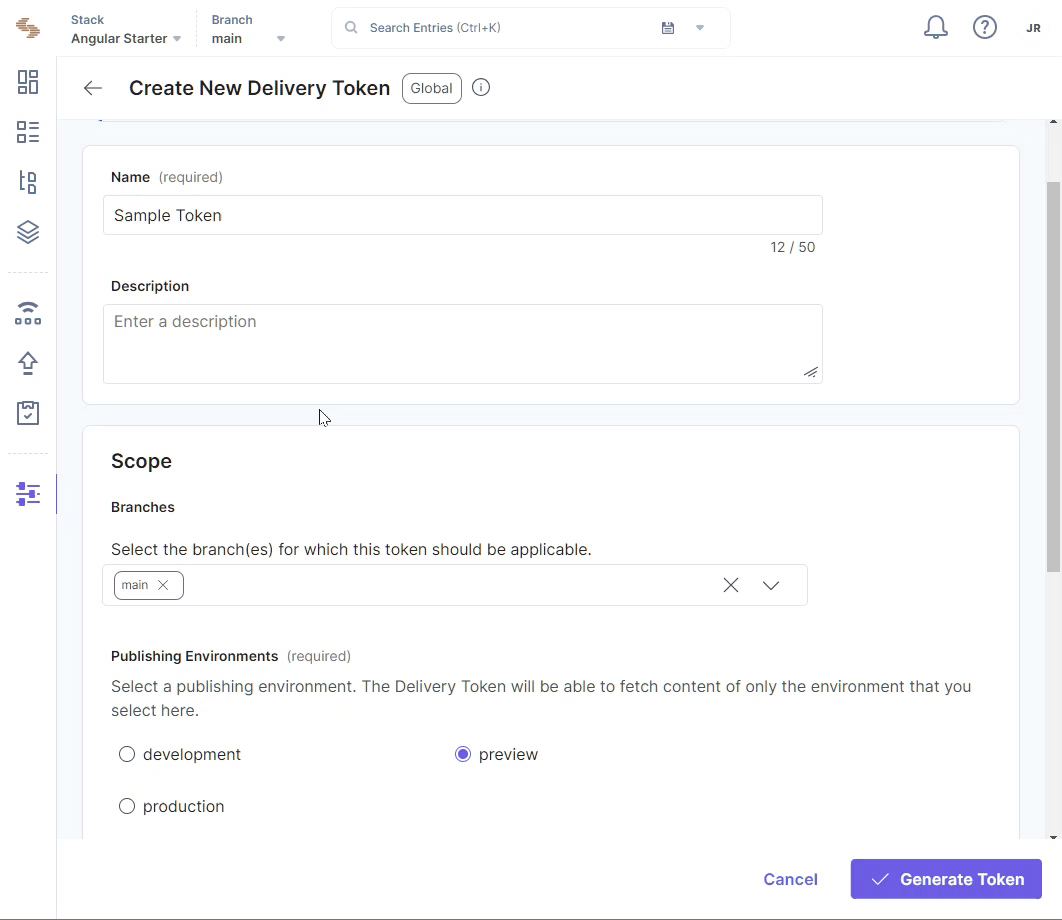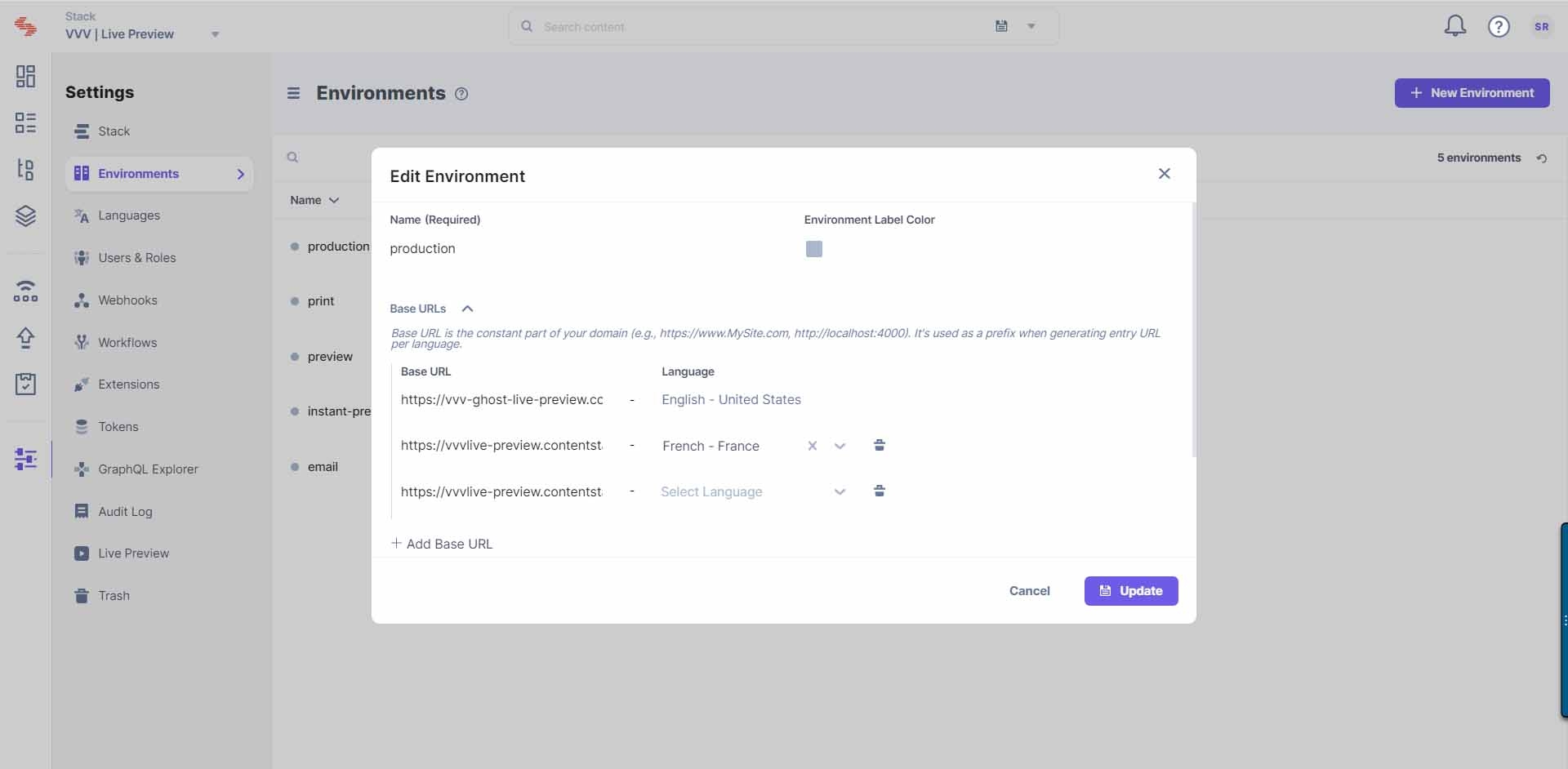Live Preview Implementation for SSR without Contentstack SDK
Server-side rendering (SSR) is the process where an application converts HTML files on a server instead of a browser into a rendered HTML client page. This guide explains in detail how to set up Live Preview for your SSR websites.
Note: This guide is focused on configuring the live preview feature for REST APIs. If you are working with GraphQL APIs, please refer to the Set up Live Preview with GraphQL for SSR document.
Prerequisites
- Contentstack account
- Access to stack settings
- Preview token
- IFrame-compatible website to avoid CORS errors
Steps for Execution
Here is an overview of the steps involved in setting up live preview with REST for your Server-side Rendering (SSR) sites:
Set up the Website
You must first set up your website. To do so, follow these steps given below:
- Generate a preview token for configuration
You can create a Preview token within the Contentstack app by navigating to Settings > Tokens > Delivery Tokens (press “alt + O” for Windows or “option key + O” for Mac).
Note: Management tokens are deprecated for Live Preview. Use Preview Tokens for configuration.
Each Preview token is associated with a Delivery token and shares access to the specific environment. Therefore, if a Delivery token doesn't exist, you must create a new one, where you can enable the Create Preview Token toggle.
For an existing Delivery token, you will find an option to generate a Preview token. Click on the+ Create Preview Token toggle and copy the resulting token number.

-
Install and initialize the Live Preview utils SDK:
The Live Preview Utils SDK listens to content changes and requests Contentstack's delivery SDK to fetch draft or preview content or process real-time content changes. Therefore, this SDK needs to be executed on the client side.
You can install Live Preview Utils SDK using two methods:
Via npm:
You can install the Live Preview Utils SDK package via npm by running the following command:
npm install @contentstack/live-preview-utils
You can now proceed to initialize the Live Preview Utils SDK by utilizing the init() method. This action establishes event listeners that monitor any modifications made to the content of the currently previewed entry.
import ContentstackLivePreview from "@contentstack/live-preview-utils"; ContentstackLivePreview.init();Note: To avoid configuration reset errors in your Live Preview setup due to rerendering, it's crucial to encapsulate your Live Preview Utils SDK initialization code within a separate JavaScript file.
Via script
To import and initialize the Live Preview Utils SDK using the script tag of the HTML file, run the following code:
<script type='module'> import ContentstackLivePreview from 'https://esm.sh/@contentstack/live-preview-utils@3.0.1'; ContentstackLivePreview.init({ stackDetails: { apiKey: "your-stack-api-key", }, ssr : true }); </script> -
Utilize the Live Preview Hash from the request query string:
When your website operates in the Live Preview panel in SSR mode, a hash is appended to the URL as a query string parameter. You can use this hash to retrieve preview data from the server.
app.get('/', async (request, response) => { const livePreviewHash = request.query.live_preview // This implementation may vary across frameworks, but the Live Preview hash will always be available in the query string. const data = await fetchData(ctUID, entryUID, livePreviewHash); ... }); -
Update the REST URL and headers
To ensure the proper functioning of the website within the Live Preview panel, it's necessary to change the REST API’s hostname. When the website operates within a Live Preview panel, the Live Preview SDK receives a hash via the URL search params in SSR mode. Consequently, you can examine this hash to switch to the appropriate hostname.
You can use similar code to fetch data from the Contentstack CDN as shown below:
function getHeaders() { const headers = new Headers(); headers.append("Content-Type", "application/json"); headers.append("access_token", REACT_APP_CONTENTSTACK_DELIVERY_TOKEN); headers.append("api_key", REACT_APP_CONTENTSTACK_API_KEY); return headers; } export const fetchData = async (ctUID, entryUID) => { const contentstackURL = new URL( `https://${CONTENTSTACK_CDN_URL}/v3/content_types/${ctUID}/entries/${entryUID}?environment=${REACT_APP_CONTENTSTACK_ENVIRONMENT}` ); const headers = getHeaders(); const res = await fetch(contentstackURL.toString(), { method: "GET", headers: headers, }); return res.json(); };In this setup, a simple configuration directs the contentstackURL to the Contentstack CDN endpoint, while the getHeaders() function generates the necessary headers for requests. The fetchData() function manages data retrieval, ensuring the correct information is fetched from the server.
You can adjust the configuration to route the API call to the preview service when the hash is available.
const CONTENTSTACK_CDN_URL = "cdn.contentstack.io"; const PREVIEW_HOST_NAME = "rest-preview.contentstack.com"; function getHeaders() { const headers = new Headers(); headers.append("Content-Type", "application/json"); headers.append("access_token", REACT_APP_CONTENTSTACK_DELIVERY_TOKEN); headers.append("api_key", REACT_APP_CONTENTSTACK_API_KEY); return headers; } export const fetchData = async (ctUID, entryUID, hash = null) => { const contentstackURL = new URL( `https://${CONTENTSTACK_CDN_URL}/v3/content_types/${ctUID}/entries/${entryUID}?environment=${REACT_APP_CONTENTSTACK_ENVIRONMENT}` ); const headers = getHeaders(); if (hash) { headers.append("live_preview", hash); headers.append("preview_token", REACT_APP_CONTENTSTACK_PREVIEW_TOKEN); contentstackURL.hostname = PREVIEW_HOST_NAME; } else { contentstackURL.hostname = CONTENTSTACK_CDN_URL; } const res = await fetch(contentstackURL.toString(), { method: "GET", headers: headers, }); return res.json(); };In this example, you can use thehash to selectively modify the hostname and headers. When it comes to enabling Live Preview, it's essential to transmit both the hash and preview_token. Optionally, to enable variant support in edit tags add the include_applied_variants header. Once you have configured this data, you can continue using REST API just as you normally would.
Note:For the North America endpoint, set the host parameter to rest-preview.contentstack.com. If your website is hosted on other data centers, pass the following:- AWS EU: eu-rest-preview.contentstack.com
- Azure NA: : azure-na-rest-preview.contentstack.com
- Azure EU: : azure-eu-rest-preview.contentstack.com
- GCP NA: : gcp-na-rest-preview.contentstack.com
To fetch content in the live preview panel, it is recommended to utilize the preview token instead of the read-only management token. For additional details, please refer to the documentation on Preview tokens.
Host the Website
To host a website, you can simply use ngrok or any other website hosting service.
Note: Make sure your website is HTTPS enabled.
Update Stack Settings
To enable Live Preview through the stack settings in Contentstack, follow the steps given below:
- Go to Settings.
- Create a new environment if there are no existing environments in your stack.
- Add your hosted website URL as the base URL for the environment created.

- Navigate to the Live Preview section under stack's "Settings".
- Select the Enable Live Preview checkbox.
- Select the Default Preview Environment from the dropdown. This helps avoid having to add the preview settings manually across multiple entries.
- Save the settings.

You will now be able to see the Live Preview icon within all the entries of your stack and the feature will preview data from the hosted website.
Live Edit Tags for Entries (optional)
Live edit tags provide a seamless way to jump directly to the specific content you want to modify within the live preview. Clicking the "Edit" button next to a content block in the preview pane automatically takes you to the corresponding field in the entry editor. If the field refers to another entry, you'll be directed to that entry's editor page for further editing.
Additional Resource: For detailed information on how to set up Live Edit tags, please refer to our documentation on Set Up Live Edit Tags for Entries with REST




.svg?format=pjpg&auto=webp)
.svg?format=pjpg&auto=webp)
.png?format=pjpg&auto=webp)






.png?format=pjpg&auto=webp)